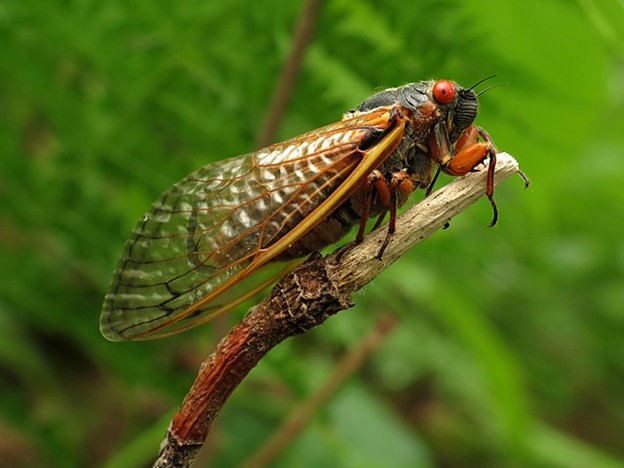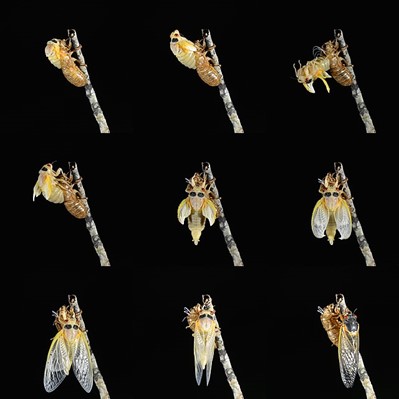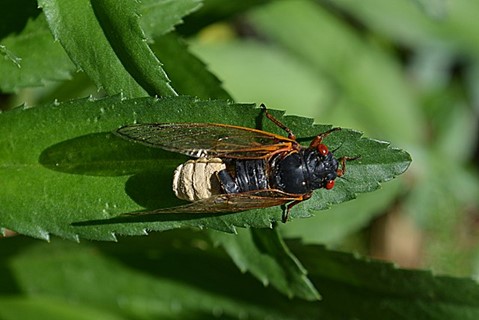
The appearance of the periodical cicada (genus Magicicada) is an extraordinary event that can evoke feelings of wonder, delight, and even annoyance or fear. But their choruses of buzzes, trills, and drones that dominate the soundscape certainly remind us to pay attention to our oft-ignored six-legged neighbors.
Endemic to eastern North America, these cicadas occur in distinct broods with 13-year or 17-year life cycles. As if by magic, periodical cicadas suddenly materialize in a synchronous mass emergence, take flight on glittering orange-veined wings, and sing in an exuberant ensemble just before a final disappearing act. Except for the occasional straggler, they are not heard again for well over a decade.

Periodical cicadas are harmless and beautiful creatures. (Photo by Katja Schulz, Wikimedia Commons)
How does a periodical cicada know when to emerge? A magician never reveals their secret; however, research demonstrates that they can count! Most of their life span (among the longest of insects) is spent underground as nymphs feeding on sap from the xylem of tree roots. Xylem transports water and dissolved minerals from the roots to the canopy, and every spring it becomes rich in amino acids. The nymphs tally these nutrient pulses to keep track of the years. As the soil warms in the spring of their final year, trillions emerge from the ground under the cover of darkness.

A cicada nymph must molt into an adult by shedding its exoskeleton, a highly vulnerable period. (Photo by G. Edward Johnson, Wikimedia Commons)
Over the course of a month or so, males sing from morning to evening by vibrating a pair of corrugated drum-like organs called tymbals, located near the base of the abdomen. Muscles rapidly deform the tymbal membrane to produce sound, which is amplified by the male’s largely hollow abdomen. A chorus can reach an overwhelming 90+ decibels! Females do not sing but will audibly flick their wings to get a male’s attention. Try snapping your fingers to see if a male has any interest in you!
This frenzy of courtship doesn’t go unnoticed by local wildlife, which gorge themselves on the defenseless cicadas, yet hardly make a dent. With predators satiated, many will live long enough to successfully mate, fueling their short adult lives with sap from woody plants. Females deposit eggs in V-shaped cuts in peripheral twigs of trees and shrubs. This causes damage known as flagging, but mature trees recover quickly and benefit from a deluge of dead cicadas that fertilizes the forest floor. In six to seven weeks, the eggs hatch into nymphs, which drop to the ground and burrow, beginning the cycle anew.

The fungus Massospora cicadina is a specialist parasite of periodical cicadas. Infections cause the rear abdomen to fall off, revealing a spore-producing fungal mass, and ‘zombify’ the cicadas, changing behavior to spread spores (e.g., infected males will attract other males using female-typical wing flicks) (Photo by G. Edward Johnson, Wikimedia Commons)
Broods are composed of multiple species with the same life cycle. While the four 13-year species are generally southern and midwestern in distribution, all three 17-year species occur in Pennsylvania. The largest, Magicicada septendecim, has an otherworldly song. The smaller Magicicada cassini and Magicicada septendecula call with various clicks and buzzes.
The emergence in 2024 is a special occasion. Two adjacent broods, the 17-year Northern Illinois Brood (XIII) and the 13-year Great Southern Brood (XIX) will emerge at the same time. This hasn’t happened since 1803, over 200 years ago when Thomas Jefferson was president!
The double brood of 2024 will not occur in Pennsylvania, but we can look forward to Brood XIV in 2025! In the meantime, enjoy the summer songs of our ‘annual’ cicada species, which have shorter and staggered life cycles, with adults appearing every year.
Written By Jason Ryndock
Ecological Information Specialist
PA Department of Conservation & Natural Resources
Bureau of Forestry | Natural Heritage Section




